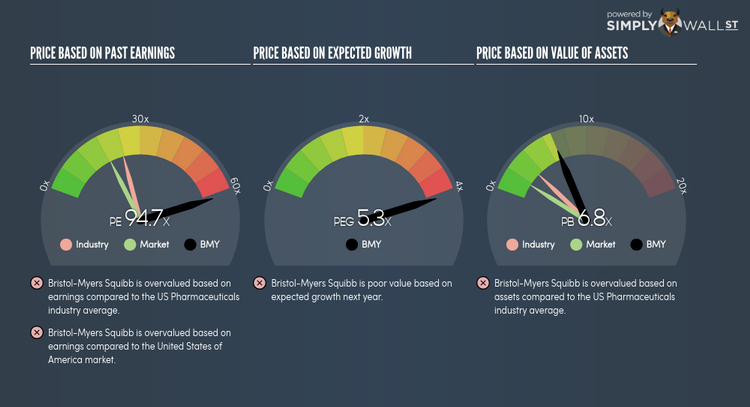Does Bristol-Myers Squibb Company’s (NYSE:BMY) PE Ratio Signal A Selling Opportunity?

Bristol-Myers Squibb Company (NYSE:BMY) is currently trading at a trailing P/E of 94.7x, which is higher than the industry average of 23.7x. Although some investors may jump to the conclusion that you should avoid the stock or sell if you own it, understanding the assumptions behind the P/E ratio might change your mind. In this article, I will explain what the P/E ratio is as well as what you should look out for when using it. Check out our latest analysis for Bristol-Myers Squibb
Breaking down the Price-Earnings ratio
P/E is often used for relative valuation since earnings power is a chief driver of investment value. It compares a stock’s price per share to the stock’s earnings per share. A more intuitive way of understanding the P/E ratio is to think of it as how much investors are paying for each dollar of the company’s earnings.
P/E Calculation for BMY
Price-Earnings Ratio = Price per share ÷ Earnings per share
BMY Price-Earnings Ratio = $53.12 ÷ $0.561 = 94.7x
The P/E ratio isn’t a metric you view in isolation and only becomes useful when you compare it against other similar companies. Our goal is to compare the stock’s P/E ratio to the average of companies that have similar attributes to BMY, such as company lifetime and products sold. A common peer group is companies that exist in the same industry, which is what I use. BMY’s P/E of 94.7x is higher than its industry peers (23.7x), which implies that each dollar of BMY’s earnings is being overvalued by investors. As such, our analysis shows that BMY represents an over-priced stock.
Assumptions to be aware of
However, before you rush out to sell your BMY shares, it is important to note that this conclusion is based on two key assumptions. Firstly, our peer group contains companies that are similar to BMY. If this isn’t the case, the difference in P/E could be due to other factors. For example, if you are comparing lower risk firms with BMY, then its P/E would naturally be lower than its peers, as investors would value those with lower risk at a higher price. The second assumption that must hold true is that the stocks we are comparing BMY to are fairly valued by the market. If this does not hold true, BMY’s lower P/E ratio may be because firms in our peer group are overvalued by the market.
What this means for you:
If your personal research into the stock confirms what the P/E ratio is telling you, it might be a good time to rebalance your portfolio and reduce your holdings in BMY. But keep in mind that the usefulness of relative valuation depends on whether you are comfortable with making the assumptions I mentioned above. Remember that basing your investment decision off one metric alone is certainly not sufficient. There are many things I have not taken into account in this article and the PE ratio is very one-dimensional. If you have not done so already, I urge you to complete your research by taking a look at the following:
Future Outlook: What are well-informed industry analysts predicting for BMY’s future growth? Take a look at our free research report of analyst consensus for BMY’s outlook.
Past Track Record: Has BMY been consistently performing well irrespective of the ups and downs in the market? Go into more detail in the past performance analysis and take a look at the free visual representations of BMY’s historicals for more clarity.
Other High-Performing Stocks: Are there other stocks that provide better prospects with proven track records? Explore our free list of these great stocks here.
To help readers see pass the short term volatility of the financial market, we aim to bring you a long-term focused research analysis purely driven by fundamental data. Note that our analysis does not factor in the latest price sensitive company announcements.
The author is an independent contributor and at the time of publication had no position in the stocks mentioned.

 Yahoo Finance
Yahoo Finance 
